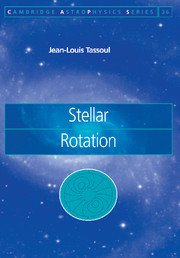1 - Observational basis
Published online by Cambridge University Press: 15 August 2009
Summary
Historical development
The study of stellar rotation began at the turn of the seventeenth century, when sunspots were observed for the first time through a refracting telescope. Measurements of the westward motion of these spots across the solar disk were originally made by Johannes Fabricius, Galileo Galilei, Thomas Harriot, and Christopher Scheiner. The first public announcement of an observation came from Fabricius (1587–c. 1617), a 24-year old native of East Friesland, Germany. His pamphlet, De maculis in Sole observatis et apparente earum cum Sole conversione, bore the date of dedication June 13, 1611 and appeared in the Narratio in the fall of that year. Fabricius perceived that the changes in the motions of the spots across the solar disk might be the result of foreshortening, with the spots being situated on the surface of the rotating Sun. Unfortunately, from fear of adverse criticism, Fabricius expressed himself very timidly. His views opposed those of Scheiner, who suggested that the sunspots might be small planets revolving around an immaculate, nonrotating Sun. Galileo made public his own observations in Istoria e Dimostrazioni intorno alle Macchie Solari e loro Accidenti. In these three letters, written in 1612 and published in the following year, he presented a powerful case that sunspots must be dark markings on the surface of a rotating Sun. Foreshortening, he argued, caused these spots to appear to broaden and accelerate as they moved from the eastern side toward the disk center.
Information
- Type
- Chapter
- Information
- Stellar Rotation , pp. 1 - 24Publisher: Cambridge University PressPrint publication year: 2000
